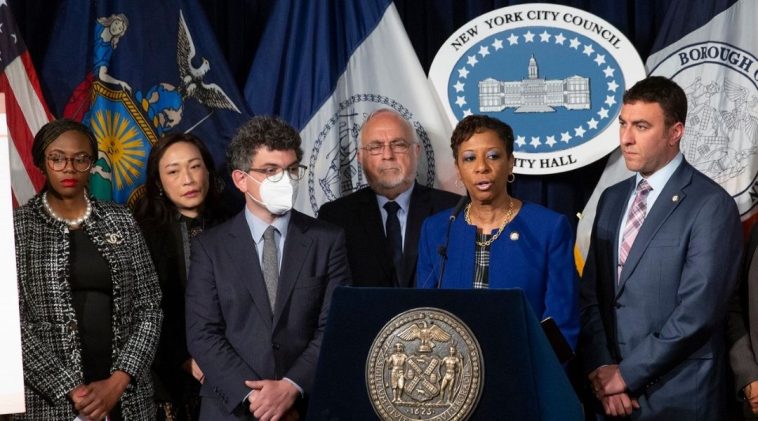A group of City Council representatives have urgently appealed to Governor Hochul to temporarily suspend New York City’s contentious ‘sanctuary city’ regulations, due to elevated terror threats linked with the continuing migrant dilemma. The sanctuary laws act as a barrier to total collaboration between U.S. Immigration and Customs Enforcement and local law enforcers. The Council members assert that these restrictions severely undermine their attempts to maintain community safety.
The rise in violent crimes, particularly those involving migrant gangs in areas such as Central Park and various parks within Queens, has sounded an alarm. These gangs have reportedly committed heinous acts from robbery and assault to rape, and even taken shots at police officers. This disconcerting state of affairs calls for prompt and uncompromising measures.
The Council’s missive duly outlined additional concerns: arrests in June in New York, Los Angeles, and Philadelphia of individuals from Tajikistan with confirmed links to ISIS-K, as well as a recent report from the Department of Homeland Security’s Office of Inspector General revealing serious deficiencies in border vetting procedures, amplify existing anxieties about terrorist threats.
The current governor holds the power to temporarily suspend the sanctuary city stipulations in NYC via executive order. However, should there be a need for any permanent amendments to these rules, approval from the City Council – with its predominantly left-leaning members – is required.
New York City’s sanctuary status has its roots steeped in history, dating back to 1989. It was former Mayor Ed Koch who first initiated this policy for the city. His aim was to protect non-citizens from deportation after reporting crime, thus creating an environment conducive to law enforcement cooperation.
Since its inception, these rules have undergone amendments on three occasions. The period from 2014 to 2018 saw a series of much-contended left-leaning policies introduced by then-Mayor Bill de Blasio and then-Speaker Melissa Mark-Viverito. These laws drastically curtailed the ability of NYC’s police, and the city’s Correction and Probation departments to collaborate with ICE agents.
Alongside restricting cooperation with ICE, these amendments prohibited municipal structures, including the Rikers Island jail facility, and other municipal resources from playing a role in the enforcement of federal immigration laws. This shift in policy imparted a clear message regarding the city’s stance on immigration enforcement.
Earlier this year, Mayor Eric Adams voiced his opinion that these rules need revisiting. He proposed a relaxation of the regulations to allow migrants suspected of serious crimes to be handed over to ICE – a practice in alignment with the city’s initial version of sanctuary laws.
Efforts to communicate with Hochul’s office for their response on the matter remained unanswered. This development further added to the uncertainty surrounding the issue and intensified the need for open dialogue and immediate action.
In a previous attempt to address the issue, Council members appealed to a Charter Revision Commission, appointed by the mayor, in June. They proposed a referendum question for the ballot to determine whether there was public support to revert the sanctuary laws to their state before de Blasio’s era.
The commission, nevertheless, chose not to entertain the proposal. They declined to take on the contentious and politically charged issue of revisiting the sanctuary laws, thereby leaving the legislation untouched for the time-being.
However, the narrative does not end there. Both Holden and Borelli, who operate as co-chairs of the Council, have drafted legislation aiming to eradicate the established sanctuary laws. They acknowledge, though, that the odds of this bill passing through are faint.
These developments highlight the governance complexities and policy challenges of New York City. The sanctuary city laws are a reflection of the city’s political and social fabric and thus, alterations to these well-established policies have far-reaching implications.
Moreover, the city’s diverse political landscape, the historical baggage, and the present migratory situation further contribute to the complexities. Given these intricacies, a unilateral approach to alter this policy could potentially invite consequences that may be undesirable or unforeseen.
Therefore, addressing the issues arising from the enforcement of these laws and handling the influence it has on the city’s demographic structure will require a balanced, considered and comprehensive strategy. This approach should match the city’s unique needs and challenges and avoid unduly tilting the balance in favor or against any one stakeholder.
In conclusion, the dialogue surrounding New York City’s sanctuary laws demonstrates the complicated interplay of politics, migration, and public safety. The outcome of these discussions will have significant implications for the city’s future, and thus it is imperative for lawmakers, political leaders and the public to carefully evaluate and respond to these developments with due diligence.


